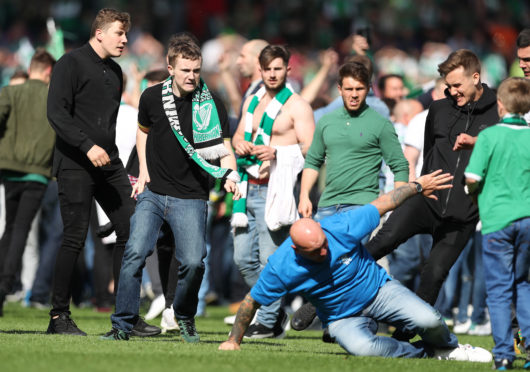
Police Scotland has been urged to remove pictures of 400 football fans from the internet after finally closing a huge investigation into a cup final pitch invasion three years ago.
The force says the inquiry is not closed but has confirmed the dedicated team of officers tasked with tracking down fans involved in violent clashes at the Scottish Cup Final in 2016 has been disbanded.
More than 180 people were arrested during the long-running inquiry but more than 400 CCTV images of match-day supporters who police wanted to interview remain online.
Dr Nick McKerrell, a lecturer in law and civil liberties at Glasgow Caledonian University, said keeping the CCTV images in the public domain represented a breach of privacy. “It might be justified if there was a live criminal investigation but that does not appear to be the case,” said Dr McKerrell.
“If you are going to keep an image of someone who has not been prosecuted for a criminal offence – I would have guessed the vast majority of those men and women on those pictures would not have been – then you can’t keep the image for lengths of time accessible by the public.”
Operation Tonish was set up in the aftermath of the violence and disorder which flared up at the end of the match between Hibernian and Rangers at Hampden Park in Glasgow on May 21, 2016.
A team of detectives began trawling CCTV, television and social media footage to identify people involved.
But, almost three years on, Police Scotland has confirmed there is no longer a dedicated team of officers investigating the trouble.
The force also confirmed 184 people had been arrested and there were no warrants still active.
The probe was launched after thousands of Hibernian fans jumped the barriers at the final whistle after seeing their team clinch a first Scottish Cup triumph in 114 years with a 3-2 victory. Some Rangers fans also went on to the pitch.
Officers working on Operation Tonish were given permission by the Crown Office to release pictures of suspects to the media.
A Scottish Police Authority (SPA) report revealed the team behind Tonish created 574 suspect profiles from their incident room at Govan Police Office.
Among those tracked down were Hibernian fan Dale Pryde, then 20, of Greendykes, Edinburgh, who in March 2017 was tagged for three months and ordered to carry out 250 hours of unpaid work after he tried to punch Rangers player Lee Wallace.
He also pleaded guilty to punching a Rangers supporter and hitting another with a chair.
Rangers fan Darren McDonald, then 40, was also snared during the operation. He was jailed for nine months in January 2017 after admitting kicking a Hibs fan.
The SPA report, published in the first year of the investigation, also revealed that at least four prison sentences had been handed out while nine people were tagged.
At least 59 football banning orders were issued, with 4,835 hours of community payback orders and £26,727 in fines also forming some of the punishments handed out.
Today, however, at least 414 images of people suspected to be involved in the incident remain online.
Dr Niall Hamilton Smith, a senior lecturer with the Scottish Centre for Crime and Justice Research at the University of Stirling, said: “The full criminal justice costs are likely to have been quite considerable.
“The question is whether this level of response over such a duration is a cost-effective use of scarce criminal justice resources.”
Police Scotland said: “The investigation is not closed and any information that is given to police will be investigated.
“The images are still online as we are still looking for information to identify them.”

Enjoy the convenience of having The Sunday Post delivered as a digital ePaper straight to your smartphone, tablet or computer.
Subscribe for only £5.49 a month and enjoy all the benefits of the printed paper as a digital replica.
Subscribe